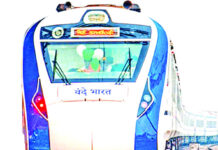The growing menace of drug trafficking in Jammu and Kashmir has reached alarming proportions, with the use of railway routes emerging as a new and concerning trend. While the Government Railway Police (GRP) remains vigilant, recent seizures over the past five days — involving heroin, cannabis, and charas — underscore the urgent need for intensified surveillance and action. The state has long grappled with drug trafficking, especially along border areas where Pakistan-backed smuggling networks have exploited porous boundaries. The stakes are high: not only does this trade ruin countless lives, but the profits often find their way into the coffers of terror organizations operating from across the border. These groups use the proceeds to fund violence, further destabilizing the region. What is particularly troubling is the shift in smuggling routes. Where once the road network was the primary conduit, traffickers are now increasingly turning to railways to move narcotics across the state. The sheer volume of daily train passengers makes surveillance challenging and gives traffickers a cover of anonymity. This transformation in modus operandi demands a recalibration of security strategy. Security agencies and state police acknowledge the nexus between drug smuggling and terrorism. While they have made multiple arrests and launched operations, the scale and persistence of the problem reveal the need for more focused and coordinated efforts. There must be stricter checks at railway stations, especially on the route from Lakhimpur to Kashmir. Additionally, special attention should be paid to suspected GRP personnel and other insiders who might be complicit or negligent. Another concerning sign is the growing number of people seeking treatment at de-addiction centers. This data reflects the alarming spread of drug abuse among the youth, further highlighting the social costs of trafficking. It is not just a law enforcement issue but a humanitarian and societal crisis. To tackle this menace, we must not only strengthen our borders and transit points but also invest in awareness and rehabilitation. The time has come to treat drug trafficking not as a peripheral law-and-order issue but as a core national security concern. The railways, once symbols of progress and connectivity, must not become arteries of destruction. It is imperative that both law enforcement and society wake up to this growing threat and act decisively — before more lives are lost to addiction and terror.

Dogra Herald is the media of J & K, breaking language and geographical barriers, connecting J & K to the rest of India.
0191 245 4946
info@dograherald.com
Latest articles
Sutherland, King and Gardner put Australia 1-0 up after comfortable win
NEW DELHI, Mar 21Australia's new golden girl Annabel Sutherland stepped in to rescue Australia in Dhaka, leading them to a 118-run win...
Uproar in RS after Rs 500 notes found in Singhvi’s seat, Cong MP says ‘Bizarre’ politics
DOGRA HERALD BUREAUNEW DELHI, Dec 6Rajya Sabha Chairman Jagdeep Dhankhar on Friday said security staff had recovered a wad of Rs 500...
Congress in desperation seeking support from anti-national forces: Dr Jitendra
DOGRA HERALD BUREAUKATHUA, Apr 13Union Minister and BJP Candidate for Udhampur-Doda-Kathua Lok Sabha constituency Dr Jitendra Singh alleged here today that the...



























